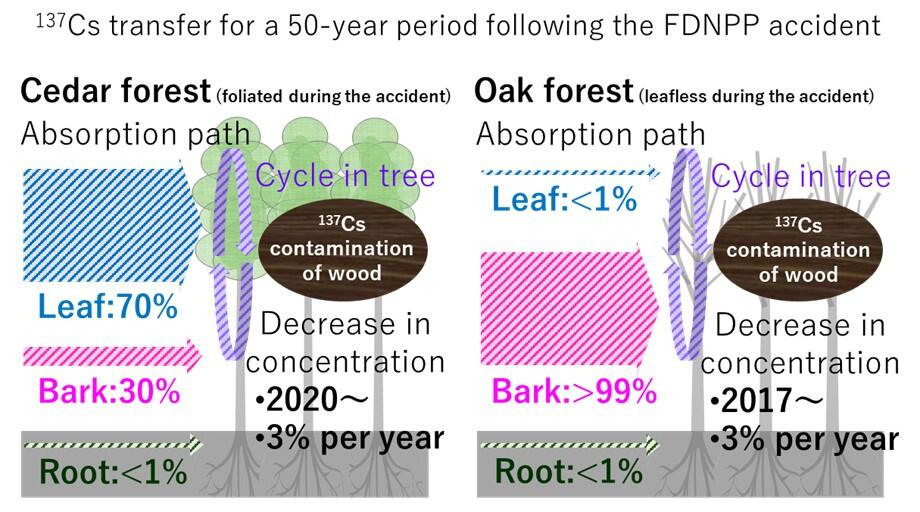Members of the research group consisting of Deputy Chief Researcher Masakazu Ota and others of the Nuclear Science and Engineering Center, Japan Atomic Energy Agency announced on January 6 that they have developed and released a computational model termed as "SOLVEG-R". The model predicts, in detail, the radioactive cesium contamination of forest resources caused by the effects of the Fukushima Daiichi Nuclear Power Station Accident. By incorporating a process that is not considered in conventional models, the group developed a computational model that can predict the movement of radioactive cesium in any forest with meteorological data. By applying the model to forests in Fukushima Prefecture, it was found that the dilution effect of xylem growth caused the concentration to decrease by 3% per year, faster than the decrease due to radiation decay. This is expected to lead to the prediction of radioactive cesium contamination, which can contribute to the resumption of forestry in the region. The results were published in Science of the Total Environment, an international scientific journal.

Provided by JAEA
Shipping limit values (radioactive cesium concentration per dry weight) have been set in the forests of Fukushima prefecture that were contaminated with radioactive cesium following the Fukushima Daiichi Nuclear Power Station Accident. For example, a limit of 50 Bq/kg was set for mushroom logs and a limit of 40 Bq/kg was set for firewood. It is necessary to predict the future concentrations in order to decide whether to resume the forestry industry. Meanwhile, research institutes around the world have conducted studies based on the Chernobyl nuclear power plant accident; in these studies, the parameters in the calculation model were adjusted and predicted using the observation results of concentration fluctuations in the forests to be evaluated. In addition, many of these computational models targeted areas that were affected by the accident and could not be applied to deciduous forests and clayey soils, which are important in the forestry industry of Fukushima Prefecture, where the soils and vegetation are different. Further, the mechanism underlying the contamination of these tree species was unknown.
From this background, the research group aimed to develop a computational model applicable to forests in Fukushima Prefecture and clarify the mechanism underlying radioactive cesium contamination in xylem, which is important for wood resources. The newly developed calculation model "SOLVEG-R" divides the above-ground part of the tree into several parts. It is possible to set the atmospheric deposition of radioactive cesium and the surface cleaning due to rainfall for each part. By doing so, the model can cover evergreen trees that had leaves at the time of the accident and deciduous trees that did not. In addition, the group introduced an element of interaction between radioactive cesium, which was not considered in existing models, and the factor of clayey soils of volcanic ash origin that are distributed in forests in Fukushima Prefecture. These movements of radioactive cesium were incorporated into a model for calculating the water cycle and tree growth using meteorological data as input values. This has resulted in a computational model that can be applied to any forest with meteorological data.
Following this, the same model was applied to two forests in Fukushima Prefecture: the cedar plantation in Otama Village (the amount of radioactive cesium deposited at the time of the accident was 68 kBq/square meter) and the oak natural forest in Kawauchi Village (510 kBq/square meter). Cedar was selected as a building material, and oak was selected as a tree species used for mushroom logs and firewood. The results suggested that the amount of radioactive cesium increased not only in the leaves, branches, and trunk bark to which radioactive cesium was directly attached immediately after the accident but also in the xylem located inside the trunk; it was predicted that xylem growth would continue for 10 years. Based on this information, the radioactive cesium deposited on trees at the time of the accident was absorbed through the leaves in cedar and through the surface in oak. Following this, it was found that the contamination that continued even after the accident was due to the part that accumulated in the trunk xylem while circulating between different parts in the tree.
The Chernobyl forest has a cold climate; radioactive cesium released from trees accumulates on the soil surface, and the amount absorbed from the roots increases after a certain period of time. However, in Fukushima, the soil was clayey and solidified, and the absorption from the roots was not large. Furthermore, when the concentration of radioactive cesium in the trunk xylem 50 years after the accident was predicted, it was shown that it peaked in 2020 for cedar and in 2017 for oak and declined thereafter. This decrease is a result of the removal of radioactive cesium deposits due to rainfall and removal due to leaf fall. The decrease in concentration contributes not only to the radioactive decay of radioactive cesium (approximately 2% per year) but also to the dilution effect of xylem growth (approximately 1% per year).
It was predicted that the concentration in all trees would continue to decline at approximately 3% per year. It is also predicted that oak will reach the shipping limit of 50 Bq/kg in 2079. Deputy Chief Researcher Ota said, "There is still a difference between observations and calculations, and the observation data used for verification are limited to 6 years after the accident. Therefore, continuous observations are needed. Further validation of the model as well as improvements in the accuracy of predictions are needed."
This article has been translated by JST with permission from The Science News Ltd.(https://sci-news.co.jp/). Unauthorized reproduction of the article and photographs is prohibited.




